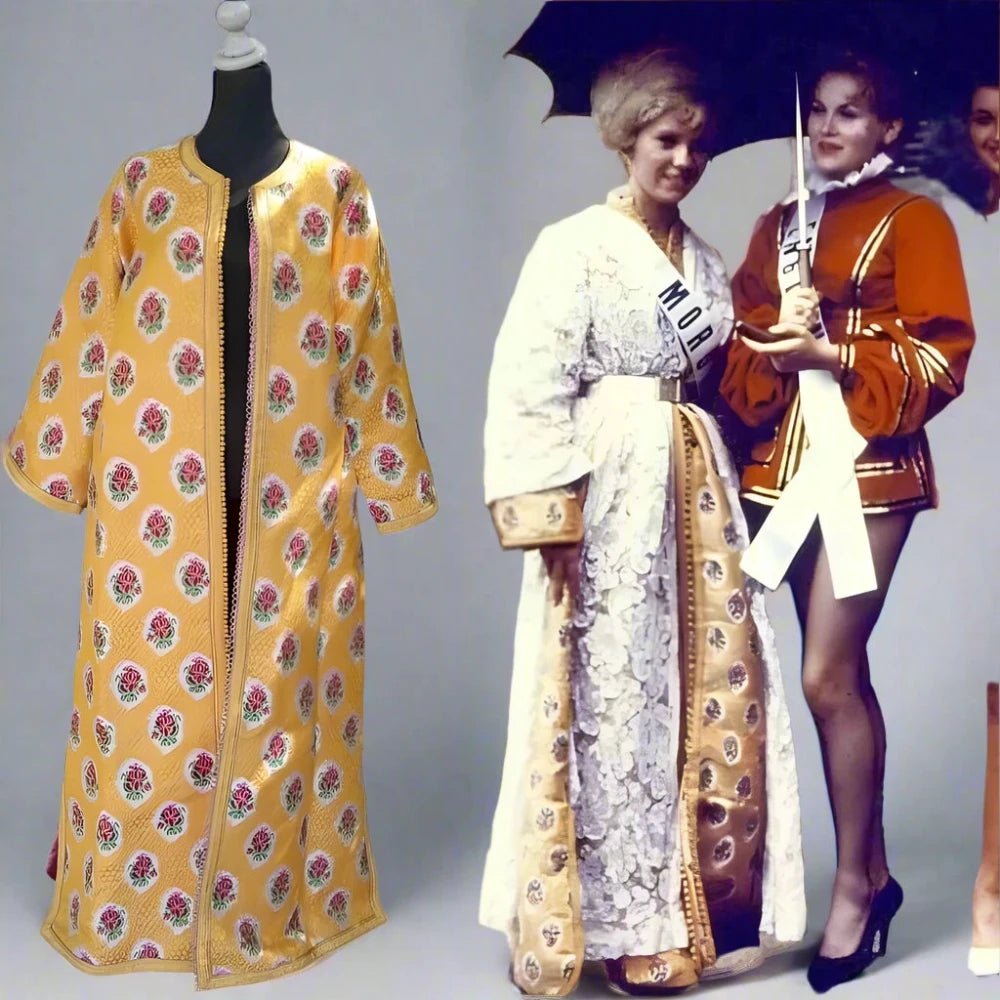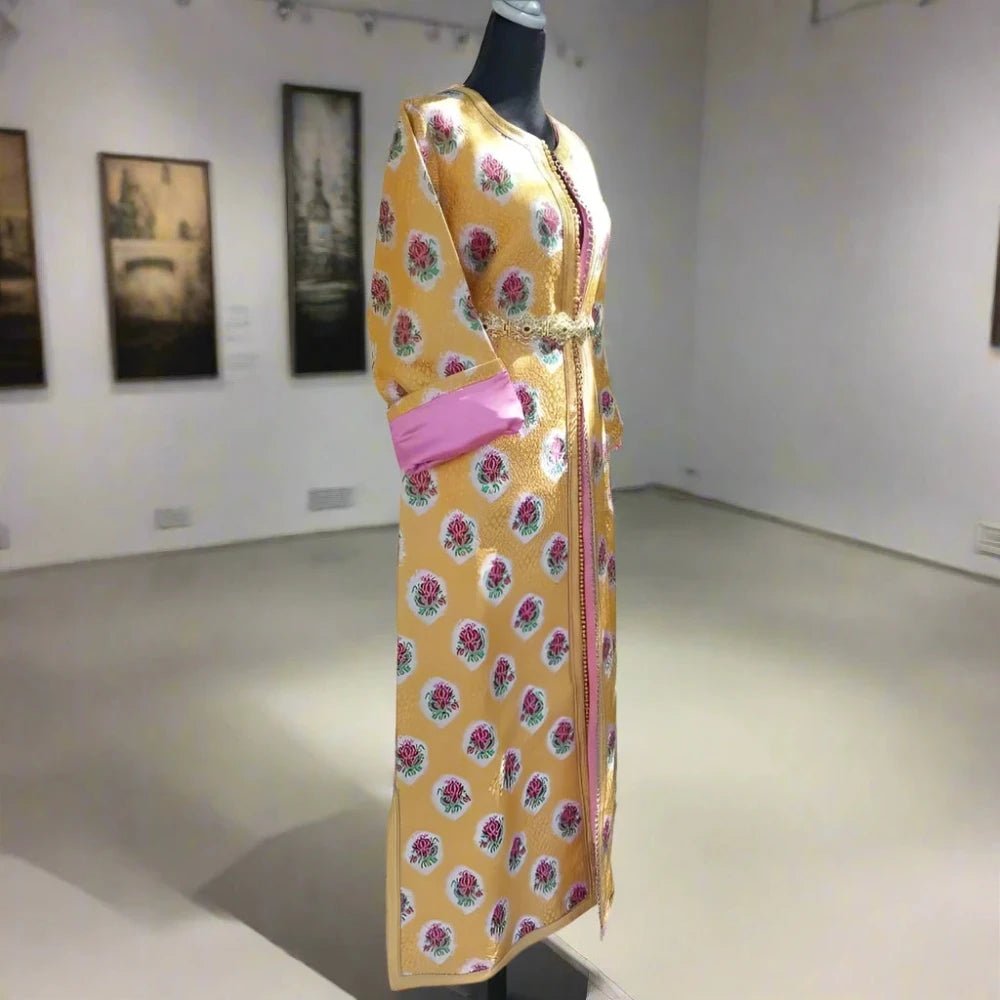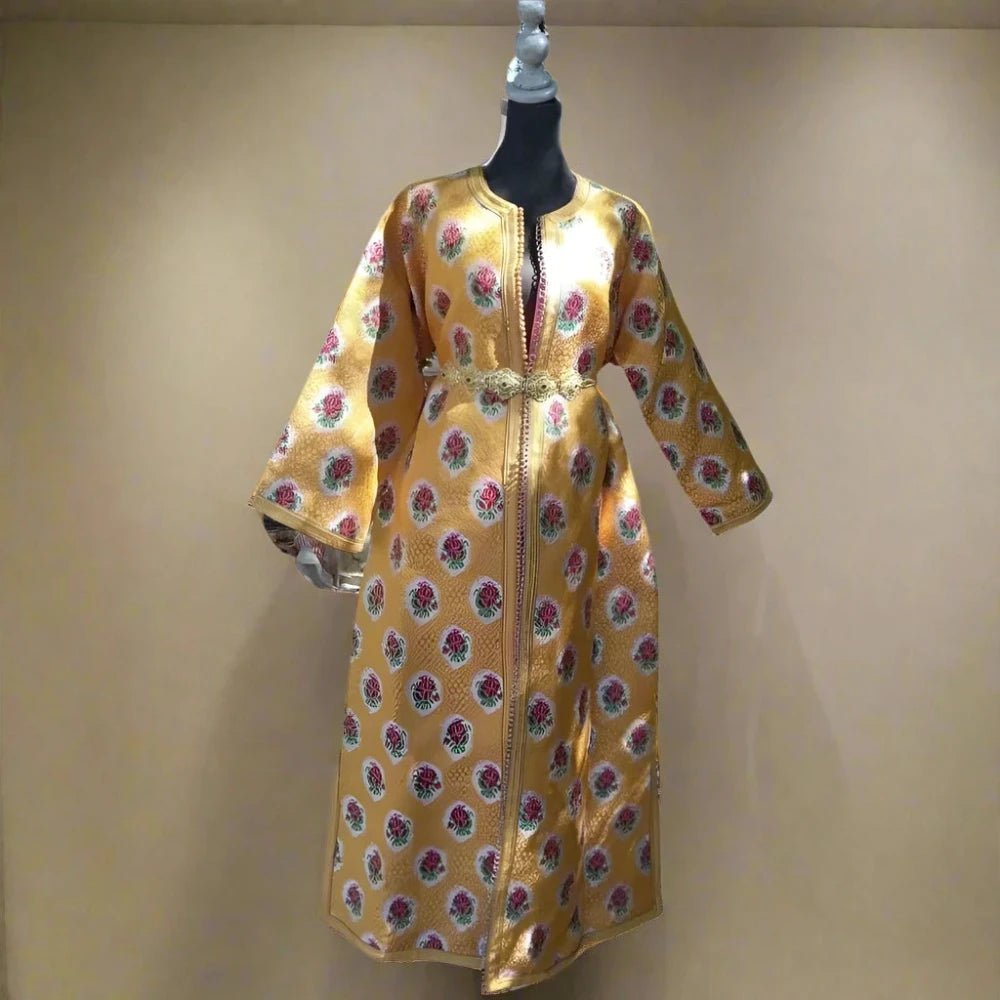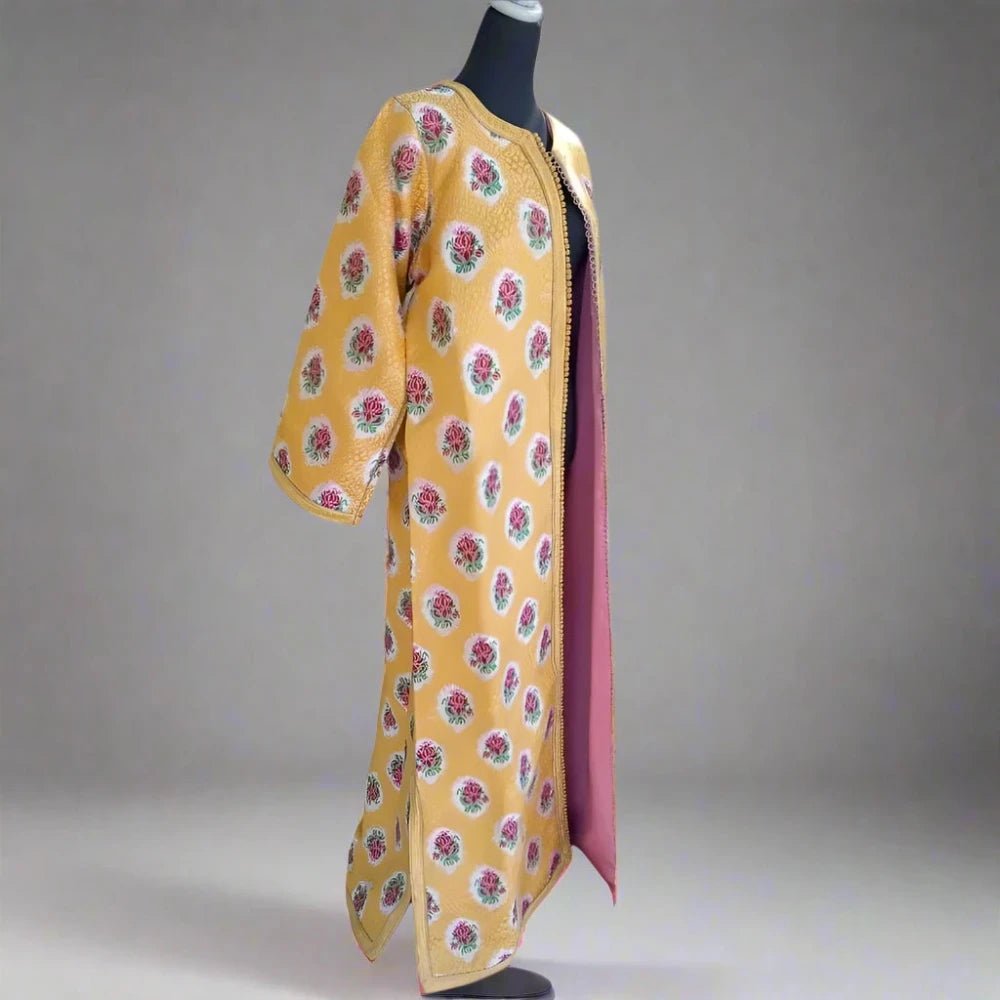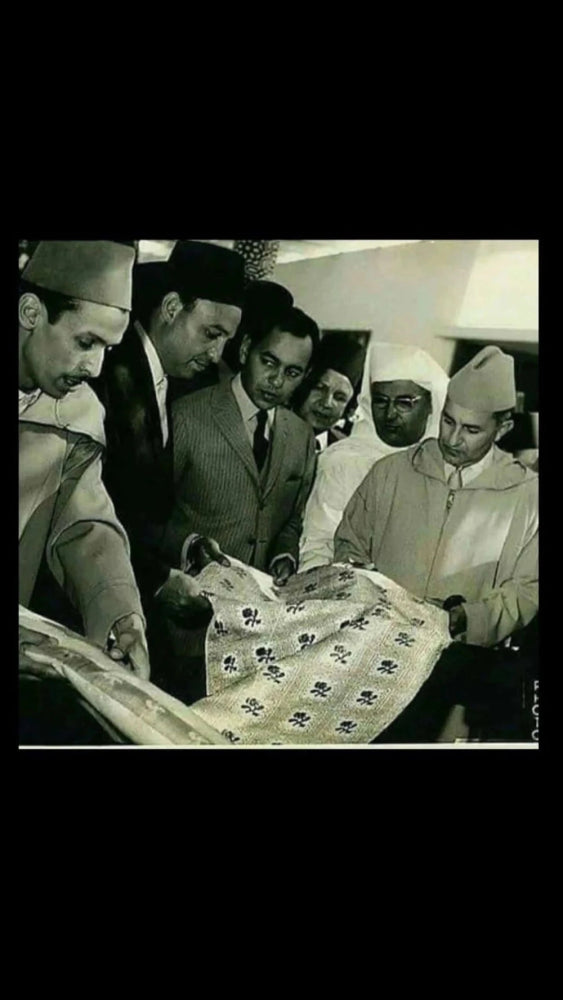
Moroccan Kaftan Khrib: A Luxurious Journey Through Fes Artisans, Wedding Attire, and Contemporary Fashion
The Moroccan kaftan, especially the luxurious khrib, represents much more than just a beautiful garment. It embodies centuries of history, meticulous Moroccan craftsmanship, and evolving cultural significance. Whether worn for weddings or cultural celebrations, the khrib kaftan reflects the elegance of Moroccan fashion, blending tradition and modern style. Let’s dive into the journey of the Moroccan kaftan khrib to uncover its origins, meaning, and place in today’s modern Moroccan kaftan trends.
Origins and Fabrication of KHRIB

Khrib Fabric: The khrib is a luxurious brocade fabric traditionally handwoven in Fes, Morocco. Its intricate patterns often feature motifs like roses surrounded by gold threads, a design that has its roots in the craftsmanship of the Bencherif family, renowned artisans who settled in Fes around 1840.
They transitioned from mosaic artistry to silk brocade weaving, becoming pivotal figures in this craft by the early 20th century.
Historical Context: The craft of handwoven brocade can be traced back to the 13th century during the Merinid Sultanate. However, by the mid-20th century, Fes emerged as the last bastion of this art form because of industrialization.
The term "khrib" itself translates to "the one who ruins," reflecting its high cost and exclusivity, especially as it became synonymous with the opulent qaftan worn during significant ceremonies like weddings.
What is the Meaning of "Khrib"?
The term khrib has a fascinating history. In Arabic, it means “the one who ruins,” referring to the high cost and exclusivity of this fabric, making it a coveted material for those who could afford it.
Over time, the khrib became synonymous with Moroccan wedding attire, especially the luxurious bridal kaftan worn during important ceremonies like weddings.
Even today, the khrib remains a favorite choice for Moroccan wedding garments, offering a touch of royalty and elegance to a Moroccan wedding dress.
Evolution of the Kaftan
Although the kaftan is now central to Moroccan cultural dress, its origins are influenced by different regions and cultures. Some historians believe that the kaftan arrived in Morocco from Persia, while others point to Ottoman influence. Still, others argue that kaftans were part of traditional Moroccan clothing as early as 680 CE, marking the beginning of the Moroccan kaftan history.
The Moroccan kaftan evolved after the 15th-century influx of Andalusian refugees, whose presence helped shape Moroccan fabric traditions and kaftan styles.

With their introduction of rich textiles and new techniques, the kaftan transformed from a simple robe into an integral part of Moroccan ceremonial dress.
The Kaftan: From Royalty to the Masses: Initially, kaftans were considered royal Moroccan clothing, reserved strictly for the elite. However, by the 17th century, they became popular among the middle class, especially during the Saadian dynasty.
The kaftan, once a simple garment, grew into a luxury kaftan—an emblem of femininity, richness, and sophistication.

Decorated with Moroccan embroidery and made from fine silk brocade, it became the perfect symbol of elegance for significant occasions.
This shift allowed women across various social classes to embrace kaftan customization and innovate with bespoke kaftan designs. Maalem tailors became central to the creation of handcrafted kaftans, personalizing each garment and bringing to life unique traditional kaftan motifs in response to individual styles.
Modern Interpretations

Today, the Moroccan kaftan, especially the khrib, remains a significant part of contemporary Moroccan fashion. It continues to evolve in the hands of artisanal kaftan designers, who balance tradition with modern fashion sensibilities. This delicate balance is celebrated at Moroccan fashion shows, such as the Oriental Fashion Show, which elevates the kaftan to the global fashion stage.
What Makes the Modern Kaftan Khrib Unique?
One of the most captivating features of the modern khrib kaftan is its uniqueness. Women collaborate with maalem tailors to create exclusive kaftan designs tailored to their tastes, making each personalized kaftan a reflection of individual style. From choosing the khrib brocade to selecting the patterns and embellishments, each heritage kaftan design becomes a one-of-a-kind masterpiece.
The personalization and high level of craftsmanship involved in the creation of a bridal kaftan or kaftan tailoring make each piece as distinctive as a fingerprint, connecting the garment to both the history of kaftans in Morocco and modern-day creativity.
Frequently Asked Questions about the Moroccan Kaftan Khrib:
-
What does a khrib kaftan symbolize? The khrib kaftan is a symbol of luxury, Moroccan craftsmanship, and cultural heritage. Traditionally worn during weddings, it remains a vital part of Moroccan wedding attire and significant ceremonies.
-
What sets khrib fabric apart from other brocades? The handwoven nature and intricate detailing, such as gold-threaded motifs, make khrib fabric a prime example of Moroccan textile art. Its high cost and association with royal Moroccan clothing add to its exclusivity.
-
Is the kaftan khrib still relevant in modern fashion? Absolutely! The kaftan khrib is celebrated in modern Moroccan kaftan trends. It is a versatile garment that adapts to both contemporary Moroccan fashion and traditional styles, making it a timeless wardrobe piece.
-
Where can I get a custom khrib kaftan? Many maalem tailors in Morocco specialize in kaftan customization, offering bespoke services to create personalized, unique handcrafted kaftans.
-
Can I wear a khrib kaftan for non-traditional events? Yes! While primarily used for weddings or Moroccan ceremonial dress, modern Moroccan kaftans can be styled for any occasion, from formal events to more casual gatherings.
Conclusion
The Moroccan khrib kaftan is more than just a garment; it is an iconic representation of Moroccan cultural attire, brimming with history, craftsmanship, and individuality. From its origins in Fes to its evolution within the world of Moroccan fashion shows, the khrib kaftan retains its place as a cherished piece of traditional Moroccan clothing. Whether you’re drawn to its luxurious fabric, intricate traditional kaftan motifs, or its deep cultural roots, wearing a khrib kaftan allows you to embrace a piece of Moroccan history.


